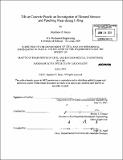Tilt-up concrete panels : an investigation of flexural stresses and punching shear during lifting
Author(s)
Bono, Matthew P. (Matthew Paul)
DownloadFull printable version (11.73Mb)
Other Contributors
Massachusetts Institute of Technology. Dept. of Civil and Environmental Engineering.
Advisor
Jerome J. Connor.
Terms of use
Metadata
Show full item recordAbstract
Tilt-up construction is becoming more popular in the United States due to its ease of construction, reliability, and relatively low construction and maintenance costs. In its most typical form, a concrete panel is cast on the ground. After the concrete sets and has reached a prescribed compressive or flexural strength, a crane lifts the panel off the ground and hoists it into place. The flexural stresses during liftoff are often times greater than those corresponding to service loads. Concentrations of high shear stress and the associated punching shear in the vicinity of the pick points could result in pullout. For these reasons, it is particularly important to design the concrete and steel reinforcement to handle the flexural and shear stresses associated with panel erection. This thesis investigates the flexural stresses and punching shear of a concrete panel designed for tilt-up. Finite element models confirm static hand calculations, and experimental results indicate that these models appropriately predicted erection stresses. The acceptability of the design provided is confirmed.
Description
Thesis (M. Eng.)--Massachusetts Institute of Technology, Dept. of Civil and Environmental Engineering, 2011. Cataloged from PDF version of thesis. Includes bibliographical references (p. 75).
Date issued
2011Department
Massachusetts Institute of Technology. Department of Civil and Environmental EngineeringPublisher
Massachusetts Institute of Technology
Keywords
Civil and Environmental Engineering.